Ah, Venice. The name itself inspires images of gliding gondolas, shimmering canals, and ancient palaces reflecting in the water. But this iconic “Floating City” is so much more than its picture-perfect postcards. It’s a place where history whispers from every stone, art adorns every corner, and magic truly feels alive.
A Brief History of Venice
Venice wasn’t supposed to be here. It was a spectacular historical accident—a dazzling, 1,000-year-long republic built entirely on a foundation of mud, brine, and audacity. The story begins in the 5th century AD, when the powerful Roman Empire was collapsing under the weight of barbarian invasions, most notably the Huns and the Lombards. The people of the mainland weren’t strong enough to fight, so they did the next best thing: they ran to the swamp.
The Venetian Lagoon, a vast area of shallow, muddy islands, was a terrible place to live—no roads, no fresh water, and hostile terrain. But that’s exactly what made it safe! The invaders, being land armies, refused to navigate the shallow, treacherous waters. The refugees built their homes by driving millions of alder wood piles deep into the clay which, because they were sealed from oxygen by mud and water, turned into stone over centuries—and that’s why Venice still floats. They literally built a city on top of a forest underwater.
Once safe, the Venetians realized their strange, watery home was perfectly positioned to control trade between Western Europe, the Byzantine Empire, and the lucrative Silk Road. By the 9th century, Venice had evolved into a self-governing city-state known as the Serenissima, which translates to the most serene republic.
The city was governed by an elected leader, the Doge, the highest official and head of state of the Republic of Venice for over a thousand years, from the 8th century until 1797. The title comes from the Latin word dux, meaning “leader” (which is also the root for the Italian duce and the English duke). He lived in the opulent Doge’s Palace and presided over all state ceremonies, but was a figurehead—a “crowned prince subject to law.”
In its heyday, Venice cornered the market on luxury goods as spices, silk, and precious jewels flowed through its canals. They became infamous for their ruthless trade practices, including an incident in 828 AD where they stole the relics of Saint Mark from Egypt, hiding the body in a barrel of pork to get past Muslim customs. St. Mark became the city’s patron saint, and his winged lion became their enduring symbol.
The Venetian Arsenal became the largest industrial complex in Europe way before the Industrial Revolution. Its standardized parts and assembly line methods allowed Venice to build and equip a massive warship in a single day, giving them naval supremacy in the Mediterranean.
Venice reached its peak wealth and artistic splendor during the Renaissance, filling its palaces with masterpieces by Tintoretto and Titian. However, its decline began as new ocean trade routes—like those discovered by Columbus—made the Mediterranean less relevant.
The end came swiftly in 1797, after 1,100 years of unbroken independence. Napoleon Bonaparte’s army marched into the city, abolished the Republic, and looted countless treasures, including the famous bronze horses from St. Mark’s Basilica. The last Doge, Ludovico Manin, was forced to abdicate as Napoleon’s forces took control of Venice.
After a few brief transfers between French and Austrian rule, Venice finally became part of a unified Italy in 1866. Today, the city remains a breathtaking monument to its past—a floating miracle of engineering, art, and unstoppable human spirit.
The Six Sestieri of Venice
Venice’s seemingly chaotic layout is, in fact, an organic result of its early growth on 118 different small islands. It was developed without a central city plan, leading to the dense, winding network of footpaths (calli) and tiny squares (campi) that define its character. Every twisting corner reveals a different view, often leading to a small, centuries-old church or a bridge that once marked the boundary of a former noble family’s territory.
There is a LOT to see in Venice, so plan to stay a few days to truly immerse yourself. The historic center of Venice is divided into six districts known as sestieri (which literally means “sixths”). Each sestiere has a distinct character, history, and a unique house-numbering system that can make navigation challenging! Here are the six districts of Venice:
San Marco is the political, religious, and tourist heart of Venice. Here you’ll find Piazza San Marco, St. Mark’s Basilica, Doge’s Palace, St. Mark’s Campanile, and the historic cafes (Florian and Quadri).
Cannaregio is the most populated and northernmost district; it is the main entry point from the mainland, and where the train station is. It has two personalities: the bustling commercial thoroughfare (Strada Nuova) and quieter, more local residential areas. Here you’ll find the world’s first Jewish Ghetto, the beautiful Gothic Church of Madonna dell’Orto, and the long Fondamenta della Misericordia (popular for bacari—wine bars).
Castello is the largest and easternmost district, it stretches from the tourist area to the tranquil, authentic residential neighborhoods and public gardens. Castello is home of The Arsenale (the massive historic shipyard), the Giardini della Biennale (site of the famous art and architecture exhibitions), and the Basilica di Santi Giovanni e Paolo.
Dorsoduro is known as the “hard ridge” (due to its more stable ground), this is the academic and artistic district, filled with students, galleries, and a vibrant bohemian atmosphere. It includes the large residential island of Giudecca to the south. Look for The Gallerie dell’Accademia, the Peggy Guggenheim Collection, the magnificent Basilica di Santa Maria della Salute, and the lively Campo Santa Margherita.
San Polo is the smallest district and one of the oldest, traditionally the commercial and business center of Venice. Here you’ll find the other end of The Rialto Bridge (connecting it to San Marco), the historic Rialto Market (fish and produce), the Basilica of Santa Maria Gloriosa dei Frari, and the Scuola Grande di San Rocco.
Santa Croce is the most accessible district from the mainland, as it contains Piazzale Roma (the bus terminal and car parking area). The western part is a transport hub, while the eastern part is historic and quieter. Look for The Fontego dei Turchi (Natural History Museum), and the Church of San Giacomo dell’Orio.
Planning Your Venice Experience
If you’re planning a trip to this dreamy destination, get ready for an adventure that will ignite your senses and capture your heart. Here are my top must-see unforgettable Venetian experiences that delve into the rich history of this remarkable city.
Piazza San Marco
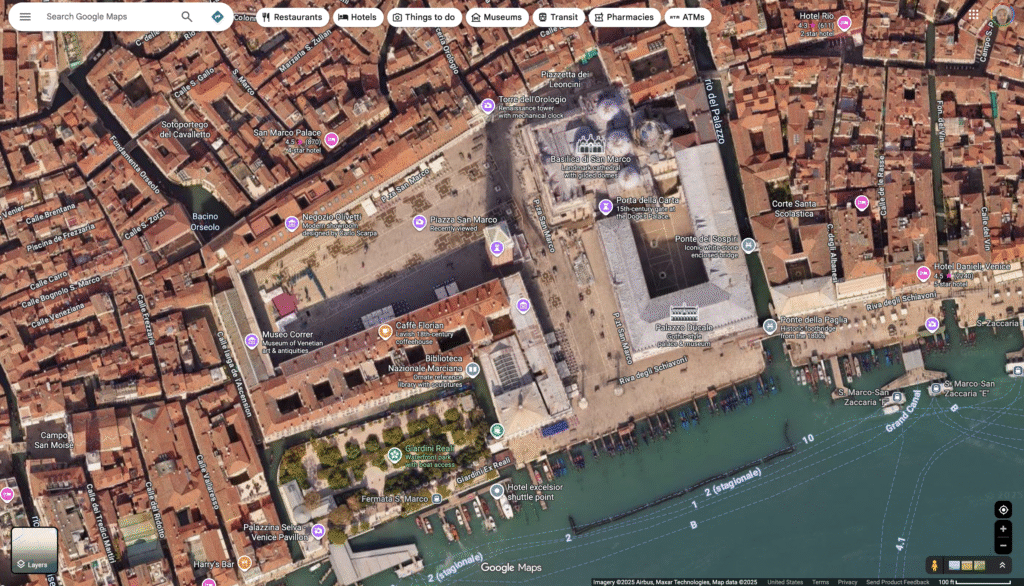
Piazza San Marco, famously called “the drawing room of Europe” by Napoleon, is the single most important square in Venice, serving as the city’s political and religious heart for over a thousand years. It was initially an orchard and garden, but began its transformation in the 9th century when St. Mark’s Basilica was constructed. Over time, it became the city’s civic and religious heart, acting as the grand stage for all state ceremonies and festivals of the powerful Venetian Republic. There are three giants that dominate the Piazza and Piazzetta (the smaller square connecting the Piazza to the waterfront).
St. Mark’s Basilica (Basilica di San Marco): the city’s most spectacular church, known for its dazzling Byzantine architecture and the over 8,000 square meters of glittering gold mosaics that cover the interior vaults and domes.
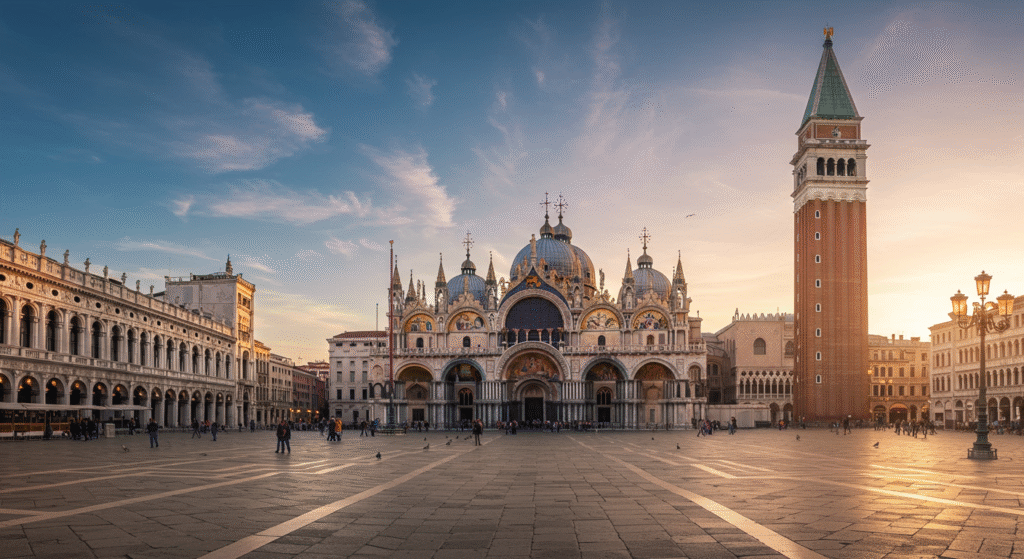
The Basilica exists thanks to an audacious act in 828 AD when Venetian merchants smuggled the body of St. Mark the Evangelist out of Alexandria, Egypt, famously hiding it in a barrel of pork to avoid Muslim inspection. The current structure, consecrated in 1094, was built to house these precious relics. It served as the Doge’s private chapel, not the city cathedral, until 1807, and its incredible gold mosaics and treasures—many plundered from Constantinople during the Fourth Crusade—were meant to symbolize the immense wealth and power of Venice as a gateway between East and West.
Be sure to see the precious Pala d’Oro, a gem-encrusted altarpiece, and the Horses of St. Mark (the originals are in the Basilica Museum). Look up at the facade’s exterior to see the four famous bronze horses—the ones outside are replicas of the treasures brought back from Constantinople during the Fourth Crusade.
The admission fee for the Basilica costs €3 for main access. There are additional fees for Pala d’Oro (€5) and the Museum/Loggia dei Cavalli (€7). As of this writing, €1.00 = $1.16573 USD, but it changes all the time. The Basilica is generally open from 9:30 AM – 5:00 PM but check the official website for variations.
Doge’s Palace (Palazzo Ducale) was the political engine of the Venetian Republic for centuries. First built in 810 AD, it was repeatedly reconstructed after fires. The Gothic masterpiece you see today primarily dates from the 14th century. It housed the Doge’s apartments, government offices, the courts, and prisons—all under one roof. The palace was the central hub where the Doge, the Senate, and the feared Council of Ten met to rule the vast, powerful maritime empire until its fall to Napoleon in 1797.
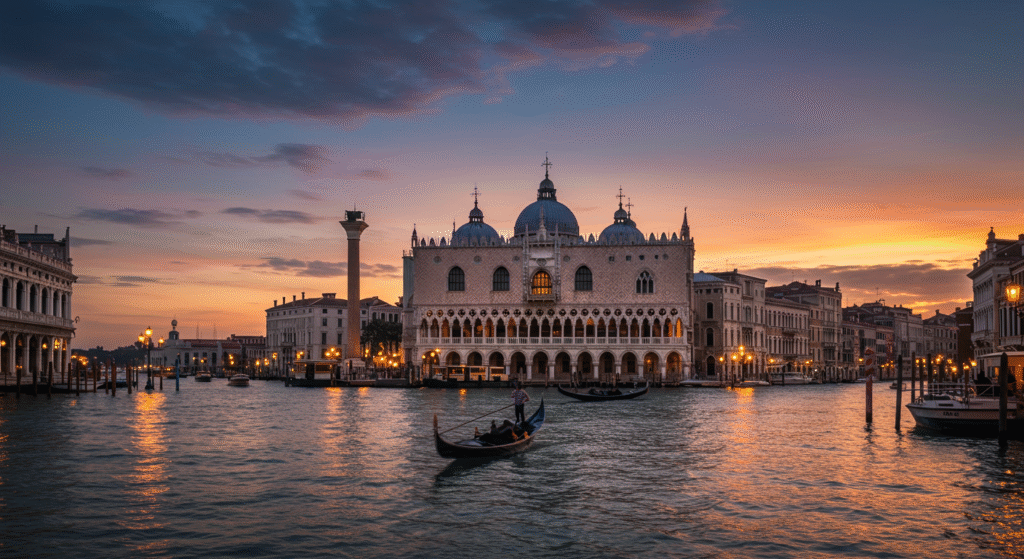
Tour its incredibly opulent halls, state rooms, and armory. The ticket allows you to walk across the infamous Bridge of Sighs (Ponte dei Sospiri), another of the most famous and photographed landmarks in Venice. This elegant, enclosed Baroque bridge, made of brilliant white Istrian stone, was built between 1600 and 1603 and designed to be a secure, elevated walkway spanning the narrow Rio di Palazzo canal. It connects the interrogation rooms in the Doge’s Palace (the old state prison and courtrooms) directly to the Prigioni Nuove (New Prisons) across the canal. Its primary function was to transport prisoners from their trial to their confinement, hence the last time they would ever see Venice as free men, which is quite sigh-worthy. Don’t miss the exterior colonnade; two columns on the Piazzetta facade are made of red marble, marking the place where death sentences were traditionally announced or carried out.
Viewing the exterior of the Bridge of Sighs is free, but to actually cross inside, you must purchase a ticket for Doge’s Palace. The admission fee runs about €30 for a standard adult ticket, and includes Doge’s Palace and several other museums. Doge’s Palace is generally open from 9:00 AM – 6:00 PM, but definitely check the official website for seasonal changes.
St. Mark’s Campanile (Campanile di San Marco) is a towering 99-meter bell tower and is the tallest structure in the city. Originally built in the 9th century to serve as a lighthouse and watchtower for ships entering the harbor. It reached its full height in 1514 and became the prototype for bell towers across the Venetian Empire. Famously, the entire tower dramatically collapsed in 1902, but miraculously caused minimal damage to the surrounding piazza. The Venetians voted to rebuild it “com’era e dov’era” (as it was, where it was), completing the exact replica in 1912.
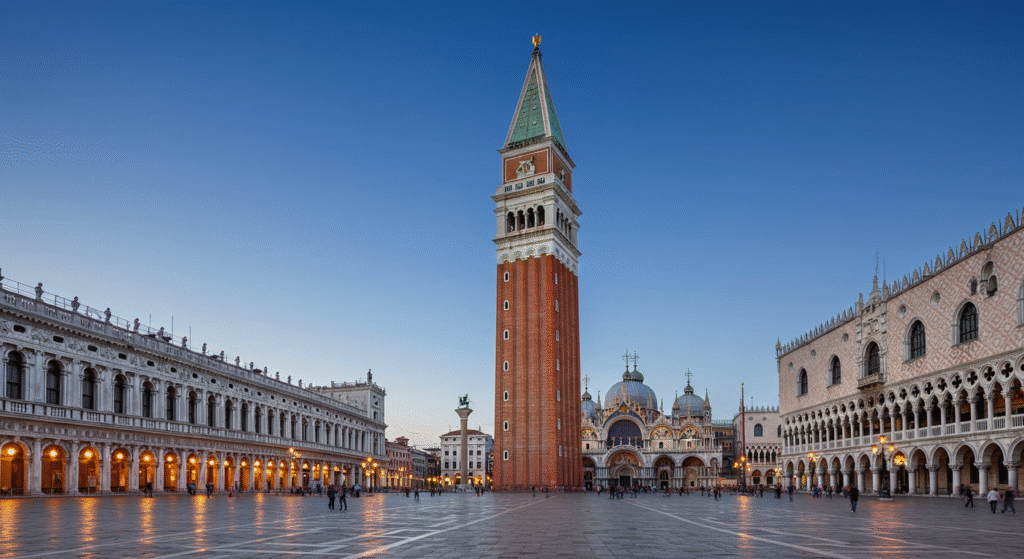
A quick elevator ride takes you to the top, offering the most incredible 360-degree panoramic views of Venice, the lagoon, and the distant Alps on a clear day. This is where Galileo Galilei demonstrated his telescope to the Doge in 1609.
Admission fee is €10, and it’s generally open from 9:30 AM – 9:00 PM during peak season. Check the official website for variations.
Torre dell’Orologio (Clock Tower) is located on the north side of St. Mark’s. This early Renaissance clock tower is famous for its large clock face decorated with gold and blue enamel showing the time, phases of the moon, and the zodiac. At the top are the “Two Moors” (Due Mori), bronze figures that strike the hour bell. Check the official website for opening times and fees.
The Frame of San Marco
The Procuratie (Arcades) are long, elegant, arcaded buildings (the Vecchie and the Nuove) frame the square. They once housed the offices and apartments of the Procurators of St. Mark, the second-highest officials in the Republic.
Tucked under the arcades are two of the world’s most beautiful and historic cafes including Caffè Florian, which opened in 1720 and is often cited as the oldest cafe in continuous operation in Europe. Stop for a famously expensive coffee or spritz and listen to the live orchestra play. Be prepared to pay a €7 per person surcharge during orchestra performances. Located across the square, Gran Caffè Quadri offers a similar historic elegance at slightly lower prices. A seated cappuccino can be around €12 at Quadri and upwards of €13.50 or more at Florian.
Located in the Napoleonic Wing at the far end of the Piazza (opposite the Basilica), Museo Correr provides a deep dive into Venetian history, art, and civilization. Your Doge’s Palace ticket often includes entry here.
Located at the edge of the water (the Piazzetta), don’t miss The Two Columns – two ancient granite columns hold the statues of the two patron saints: St. Mark (represented by the Winged Lion) and St. Theodore (Venice’s original patron saint, standing atop a crocodile). Local superstition warns Venetians never to walk between them, as this was the site of public executions.
The Rialto Bridge
A short walk will bring you to the Ponte di Rialto (The Rialto Bridge) is the oldest of the four bridges spanning the Grand Canal. Ponte di Rialto is located roughly midway between Piazza San Marco and the northern end of the main island. It replaced a series of wooden bridges that had collapsed or burned down, including one with a drawbridge to allow passage for the great sailing ships. A competition to design a permanent stone bridge was held in the late 16th century, which included designs by masters like Michelangelo and Palladio. A man named Antonio da Ponte won the competition, and the current bridge was built between 1588 and 1591. Its audacious single arch was the only fixed crossing point over the Grand Canal for nearly 300 years.
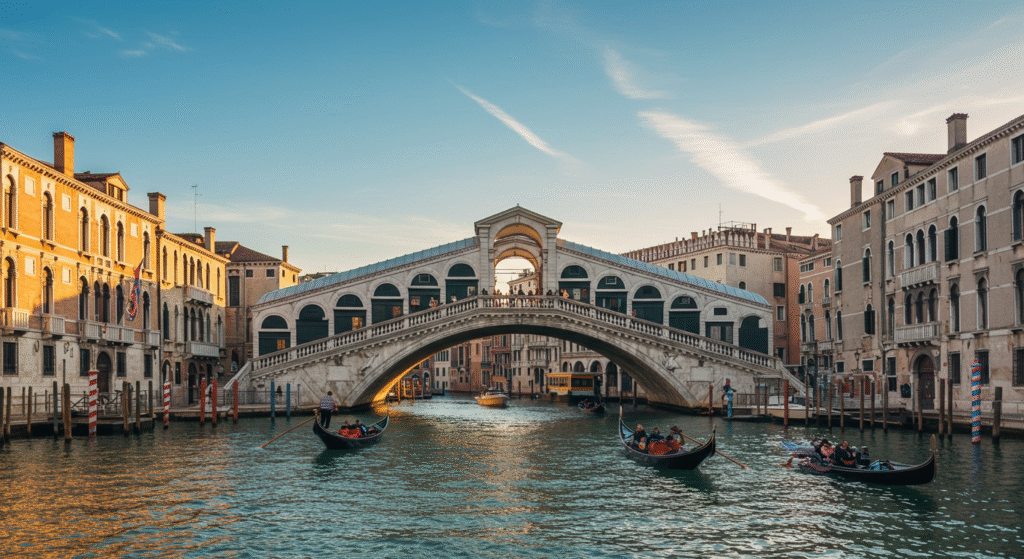
The Rialto Bridge connects the districts of San Marco and San Polo. It crosses the Grand Canal at its narrowest point.
The bridge is free to cross, and is one of the most visited sites in Venice. It is fairly crowded for most of the day, particularly during the peak tourist season (spring through early autumn). The best times to visit for less crowds is in the morning before 10 AM, or around dinner time.
What to Know About Gondola Rides
A ride on a gondola has been a staple of Venetian life since at least the 11th century. By the 17th and 18th centuries, there were thousands of them, serving as the city’s primary form of transport. They were originally brightly colored and ornately decorated, leading to such excessive displays of wealth that in the 17th century, a sumptuary law was passed, mandating that all gondolas be painted black to curb aristocratic extravagance. Today, the gondola’s distinct, asymmetrical shape—perfect for rowing through narrow canals with a single oar—is a masterful example of Venetian naval engineering.
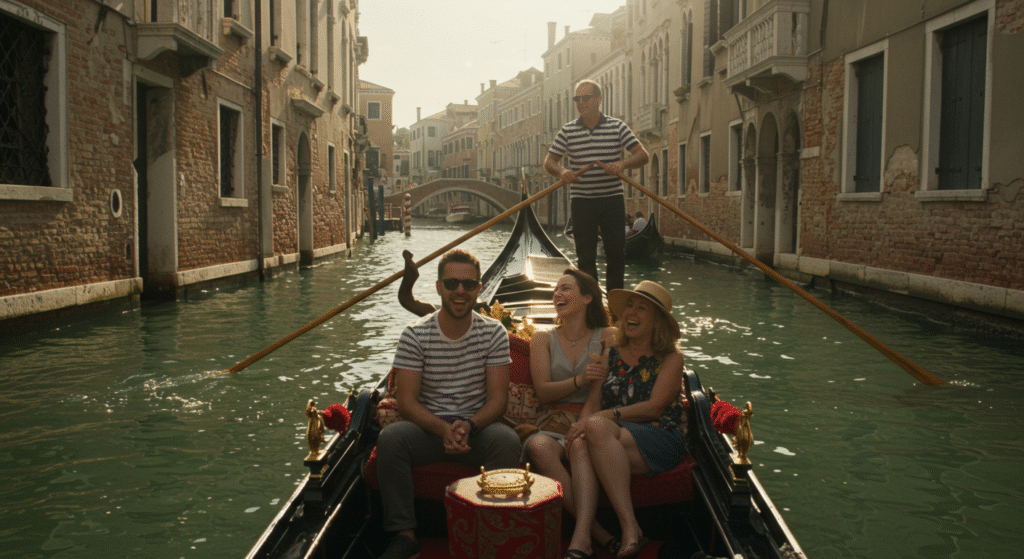
Gondola rides aren’t cheap. In the daytime, expect to pay upwards of €80 for a 25-30 minute ride, and about €120 at night. Load up your peeps and split the fee – you’re charged per ride, not per person. A typical gondola will hold up to five passengers plus the gondolier. Sometimes they’ll count babies, sometimes they won’t.
And bundle up in the winter – it gets quite cold on the water. The gondoliers often provide passengers with heavy blankets to keep warm during the ride, but dress warmly regardless.
Murano and Burano
These two islands have distinct histories tied to two ancient trades. Murano became the center of glassmaking in 1291, when all glass furnaces in Venice were moved there to prevent accidental fires in the main city. The glassmakers enjoyed special privileges but were strictly forbidden from leaving the Republic to protect the secrets of their trade.
Burano, meanwhile, was a simple fishing village whose residents began to distinguish their houses with bright, bold colors so fishermen could find their homes in the thick lagoon fog. It also became a major European center for exquisite needle lace.
The Grand Canal
The Grand Canal is Venice’s central, S-shaped waterway, believed to follow the course of an ancient river. For centuries, it served as the city’s most important commercial artery, lined with the palaces (palazzi) of wealthy merchant families. These palaces, designed with prominent water entrances and large storage rooms (fondaco) for goods on the ground floor, showcase a stunning progression of Venetian architectural styles—from Byzantine and Gothic to Renaissance and Baroque—each representing a family’s influence and wealth.
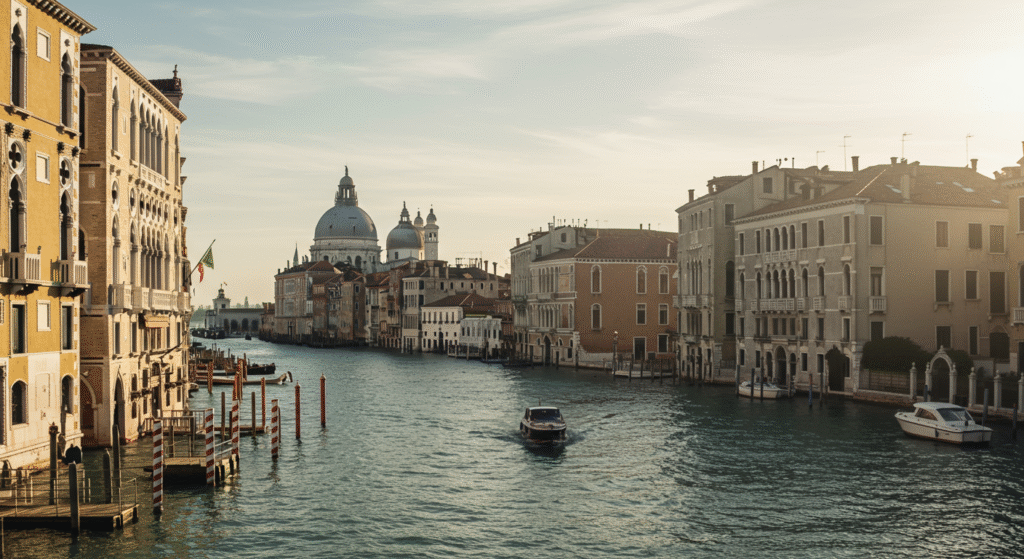
You can take a single ride on the ACTV Vaporetto for €9.50, or get a 24-hour ticket for €25. If you’re more bougie, private water taxis will run €100 – €150+ per group of up to four people. There may be a surcharge for larger groups.
Getting Around Venice
Venice’s public transportation system is primarily water-based, using a combination of public “water buses” and private boat taxis. The entire system in the city and mainland Mestre/Marghera is managed by the company ACTV.
Vaporetto (Water Bus)
The Vaporetto is Venice’s public water bus system and the most essential and affordable way for visitors to get around, especially for trips along the Grand Canal or to the outer islands like Murano and Burano.
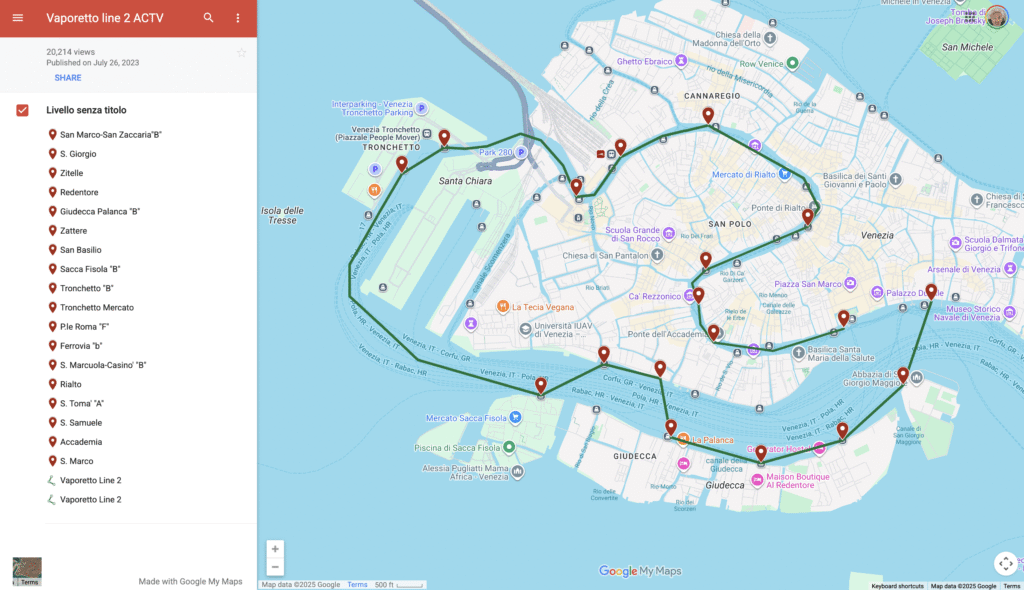
| Ticket Type | Price (approx.) | Notes |
| Single Ride Ticket | €9.50 | Valid for 75 minutes. Only economical if you are using it once or twice. |
| 1-Day Pass (24 hours) | €25 | Unlimited travel on Vaporetti and mainland buses/trams. Recommended if you plan more than 2-3 rides. |
| 2-Day Pass (48 hours) | €35 | |
| 3-Day Pass (72 hours) | €45 | |
| 7-Day Pass | €65 | |
| Rolling Venice Youth Pass | €27 | Special 3-day pass for youth aged 6 to 29 (requires purchasing a separate €6 Rolling Venice Card first). |
Tips for using Vaporetto:
- Validation is Mandatory: You must validate your pass by tapping it on the electronic readers at the pontoon entrance before boarding the boat to avoid a fine. Ignorance or language cannot be used as a valid defense.
- Routes: Line 1 is the leisurely, scenic route that stops at every station along the Grand Canal. Line 2 is a faster, express route for key stops.
- Children: Children under the age of six travel for free.
Airport Transport (Separate Fares)
Standard ACTV Vaporetto passes do not cover transport to/from Marco Polo Airport (VCE).
The Alilaguna Water Bus is a private boat service that connects Marco Polo Airport directly to various stops in Venice (like St. Mark’s and Rialto). The cost is approximately €15–€18 for a single one-way ticket.
The ACTV Aerobus (Bus #5) is a regular road bus connecting the airport to Piazzale Roma (the main bus and car terminal at the edge of Venice) A separate ticket is required, but it’s slightly cheaper than the Alilaguna (often around €10).
Water Taxis and Gondolas
These are private services and are much more expensive, but offer speed and convenience (water taxis) or a unique experience (gondolas).
| Transport Mode | Purpose | Approximate Cost |
| Water Taxi (Motoscafo) | Private, direct transport. | €100–€150+ per group of up to 4 for a typical journey (e.g., airport to hotel, or between districts). |
| Gondola Ride | Private, scenic experience, fixed duration. | €80 (Daytime, 30 min) / €120 (Nighttime, 30 min) per boat (up to 5 people). |
| Traghetto Gondola | Quick, cheap commuter crossing of the Grand Canal. | €2 (cash only) per person. |
If you just need to cross the Grand Canal between Vaporetto stops, look for Traghetto signs. These are old, large gondolas rowed by two men that shuttle passengers across at fixed points for a nominal fee.
Let us know if you have any tips on what to see or experience in Venice! Enjoy your trip!






